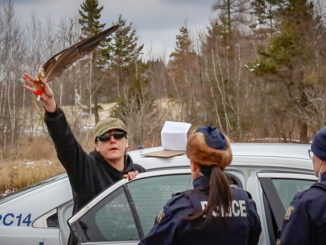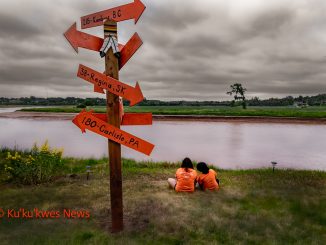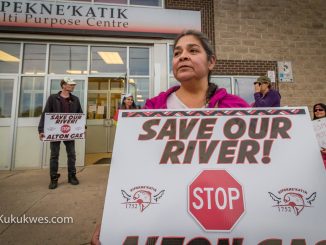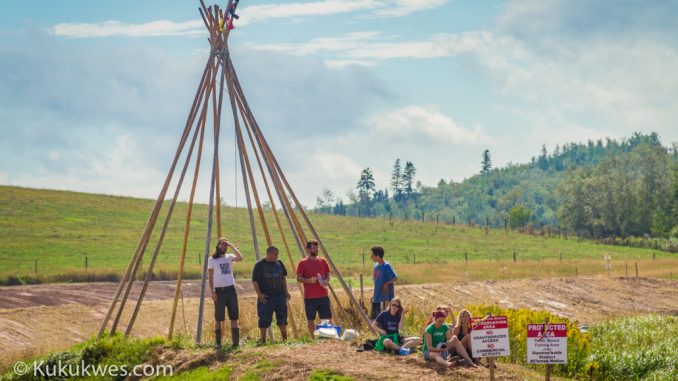
A group that opposes the Alton Natural Gas Storage project along the Shubenacadie River near Stewiake, N.S. has set up a teepee frame on a tiny, man-made island in the river to mark it as traditional Mi’kmaw territory.
Cheryl Maloney, president of the Nova Scotia Native Women’s Association and a Sipekne’katik band councillor, explained they’re using the island so they can safely check their eel traps and conduct their own conservation studies.
“We tried to fish our little trap there and we kept trying and they kept hindering us,” Maloney explained moments after she returned from the tiny island Sunday afternoon.
“They put up more fencing. They put up more signs. It was just becoming impossible to fish,” she said.
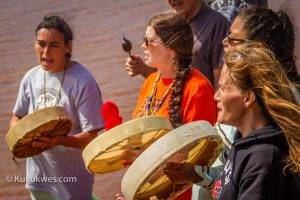
A group of Mi’kmaw women stood along the banks of the Shubenacadie River adjacent to the island singing songs in Mi’kmaq with their hand drums while the others set up the teepee frame. A small group of supporters walked passed the company’s fence to stand behind the singers. Several security guards stood nearby while the women sang.
“We wanted to support with our voices as they were putting the teepee up over there on Treaty Island as we’re calling it now,” said Michelle Paul, one of the drummers and singers.
“We wanted to send some good energy across that little channel there and help them with their energy as they were throwing the traps in the water,” she added.
People from Cape Breton and New Brunswick joined local residents and Sipekne’katik band members along the banks of the Shubenacadie River next to the Alton company site over the weekend. People sat under several tent canopies near a small shack, called the Treaty Truckhouse, that was built on the site during Labour Day weekend.
Several children brought fishing polls and nets to the river bank to exercise their Mi’kmaw treaty right to fish.
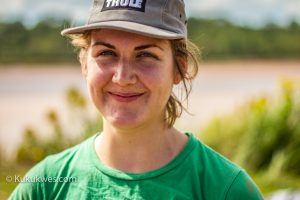
Emma Norton, 26, from Halifax came to the site to help the group build a fish weir. Instead, she helped with the teepee frame and eel traps.
“This morning was really powerful. I felt really lucky and honoured to have been on the island and watching Dorene Bernard show us how to build a teepee,” Norton said.
“They were able to turn, what is kind of a gross location into something that is really meaningful and powerful and showing that they have ownership of that island. It’s their land,” she added.
Island is part of a protected, traditional Mi’kmaw fishing area – Maloney
There has been ongoing opposition from local residents and the Mi’kmaw community over the Alton Natural Gas Storage project since 2014. As part of the company’s plans to store natural gas in underground salt caverns in the area, they’re removing salt formations from the ground by using water from the Shubenacadie River.
The company plans to store the salt water mixture, called brine, in holding ponds to dilute it before releasing it back into the tidal Shubenacadie River.
In addition to setting up the teepee, Maloney said they put up their own conservation signs to indicate the island is a part of a protected, traditional Mi’kmaw fishing area.
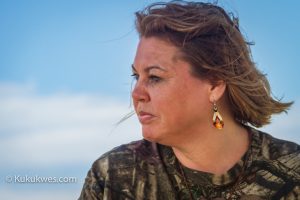
“We have our signs. It’s Mi’kmaq territory. It’s unceded Mi’kmaw territory,” Maloney said. “Alton may not want us to be there but nobody has yet brought us anything giving them good title to the territory,” she said.
“We’ve been only going forty feet into the fence to check our traps. They’ve been calling the cops,” Maloney added. So far, the group has caught one eel in the trap set from the tiny island, she said.
Five RCMP vehicles were parked at the main entrance to the project site on Sunday. Several uniformed officers were seen talking with the company’s security guards. Two plain-clothed RCMP officers with the Indian Brook First Nation detachment were mingling with the group next to Alton Natural Gas Storage project site.
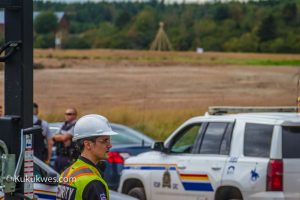
In a written statement issued on Sunday, a company spokeswoman wrote the RCMP were called because “some individuals entered the active work site, including an island adjacent to the mixing channel for Alton.”
“At Alton, we respect the right of individuals to express their views safely and peacefully,” Lori Maclean wrote. “However, the Alton river site is an active work site with construction hazards. Access to the site is restricted for public safety reasons,” she wrote.
Maclean also wrote that “Alton has received all environmental and industrial approvals for construction.” She stated that the approvals were given a result of an environmental assessment of the project as well as eight years of scientific monitoring of the Shubenacadie River.
Meanwhile, Maloney said the group opposing the project will continue to get ready this week to begin its own scientific monitoring of the river as the company gets ready to release brine into the river.
“We’ll have a wharf coming in so we can get better access to the (river) bank. The tides here, they’re the highest tides in the world,” Maloney said. “We’re just establishing, you know, a base camp for science and a base camp for fishing.”

